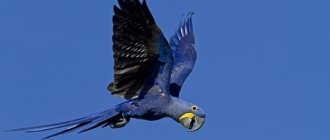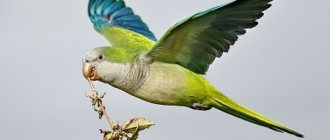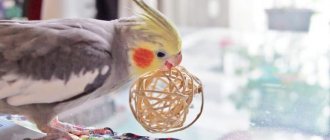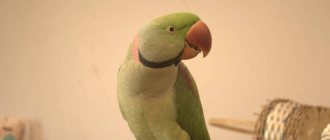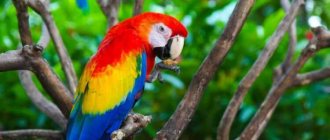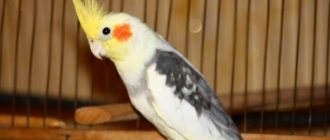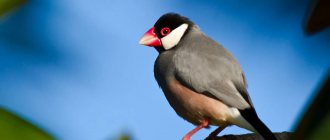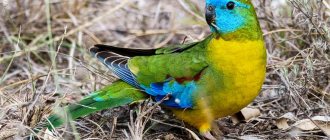The most spectacular macaw parrot in the world deserves an excellent rating: the most beautiful, smartest, rarest, most expensive and largest of the representatives of the parrot family. The elite bird is protected by law, while several species are endangered, and the blue macaw lives and breeds only in captivity. The article contains basic information about the noble macaw parrot: where it lives and what it looks like, why it is interesting and whether it is possible to keep an exotic pet at home.
Hyacinth macaw
general description
The macaw parrot is the most colorful of exotic birds. The coloring of this bird shimmers with all the colors of the rainbow: yellow, blue, light blue, orange, red. This is undoubtedly mesmerizing, so you can admire such a handsome man for hours.
In addition to the fact that it is the most “colored” bird of the parrot family, it is also the largest. The size of some individuals, including the tail, can reach 90–98 cm, and the span of the large pointed wing can reach 40 cm.
The large wedge-shaped bright tail is much larger than the body itself. The area near the eyes on the sides of the macaw's head is almost bare - with only a very small number of short feathers folded into a certain pattern. The special asset of this bird is its unique beak. It is very large, compressed from the sides and sharply rounded down, like a hook. But besides all this, its beak is incredibly strong.
Species of macaw parrots
Soldier's Macaw
One of the largest species, its length can reach about 80 centimeters. It got its name because of the coloring characteristic of the colors of military uniforms. Mostly the feathers are dark green, but on the head (approximately at the back of the head) they smoothly turn into blue. On the wings the outer feathers are bright blue, on the tail there are several scarlet feathers, and the main color is brown. Also neatly above the beak is a bright red wide strip of short feathers.
- How much does a raccoon cost?
- Interesting facts about cats
- The richest animals
- Cat claw attachments
- Dog
- Long-eared cats
In captivity, it can only be kept alone, because only in this case does it begin to trust the owner and become tame and obedient. However, in small flocks the birds will remain wild. Its subspecies, the Lesser Soldier's Macaw , is a real long-liver. With proper maintenance and gentle handling, its lifespan can reach up to hundreds of years.
Blue and yellow macaw
One of the most beautiful species of parrots. Its color is dominated by two colors, as the name suggests – soft blue and bright yellow. Blue - “back side” - the upper part of the neck, wings and back. Yellow – “front side” – chest, belly, tail. There is also a green “cap” on the head.
When it comes to keeping a macaw parrot of this species, it is quite demanding and whimsical. This species is also distinguished by its intelligence and ability to impress the human voice. Despite their popularity as pets, they require constant attention and supervision.
The negative features of such parrots are their noisiness and destructive nature. They do not have the most pleasant and harsh voice, but this does not stop them from yelling all day long. They also need constant beak training, which is why they constantly gnaw on everything, including pieces of furniture, and can easily bite through even thick steel wire.
Green-winged macaw
Because of its beauty and ability to learn entire phrases, it is one of the most popular species of poultry. The color is mostly bright red, but there are blue and green feathers on the wings. The beak and cheeks are white. In combination, all this makes the parrot bright and beautiful.
In captivity he feels excellent. Possessing a calm disposition, it is not as harmful as its blue-yellow “comrade”. Thanks to his excellent intellect and memory, he can not only learn words, but also put entire phrases together from them. At home it can live up to fifty years, but does not reproduce very readily.
Red Macaw
It lives quite rarely in captivity, because it is a surprisingly freedom-loving bird. However, if you are “lucky” to have a red macaw, then be prepared for the fact that it constantly and loudly screams, and also requires free space, which, due to its enormous size, is very difficult to provide. But he can learn up to a hundred words.
Unlike the soldier's macaw, he was not particularly loved by people. Due to the fact that such birds gather in large flocks, which, like locusts, devour everything in their path, it was declared a pest. And due to its considerable size and mass, it was constantly hunted. By the way, in terms of nutritional qualities, its meat is not only tasty, but also healthy. Red macaws are one of the most numerous parrots that are found in abundance in the wild, but are practically not kept in cages or aviaries.
Chestnut-fronted macaw
Many species of macaw parrots refuse to breed in captivity, despite the owner creating the most comfortable conditions for them. Therefore, they are “bred” in the wild, periodically collecting chicks from nests and raising them at home. One of these species is the chestnut-fronted macaw, a not very large, beautiful bird whose color is dominated by green and red tones. It got its name because there is a small dark area above the beak.
Due to their small size and ability to learn - such parrots are able to remember not only speech, but also music - the chestnut-fronted macaw is quite common in captivity. But the unpleasant voice, which almost all macaws have, and a strong beak, thanks to which it can bite through wire, make keeping such a bird in an apartment problematic.
Yellow-necked Macaw
The “silent” macaw is difficult to find, but still possible. This is why the yellow-necked macaw is so common in captivity. Because of his calm disposition, he screams much less often than his brothers, and is also very trusting of his owner and obedient, like a dog. Parrots are small, the main color is green. It got its name because of the yellow “collar” on its back. It is unpretentious and prefers vegetables and corn in its diet.
Features lifestyle and habitat
Parrots of this species prefer to settle in tree hollows, at a sufficient height from the ground. Pairs are created for almost a lifetime, so after the death of a partner, the bird is sad and does not try to find a replacement. The mating season varies depending on the species, but chicks are not hatched annually.
The macaw is one of the flocking birds, and almost a hundred individuals can unite in one group. Such large flocks very often become a real disaster for large fruit plantations.
The bird is very demanding about its diet, which necessarily includes fruits, berries, vegetables, nuts, herbs, plant seeds, as well as various cereals, including corn, wheat and barley. This species of bird, like most of its counterparts from other genera of macaws, lives in forested areas in countries such as Brazil, Paraguay or Bolivia. If you believe some data, then this parrot used to live in Trinidad, but eventually became extinct.
In its natural habitat, this parrot prefers to stay alone or in the company of its mate, formed during the mating season. Together they spend the whole day searching for food, while the birds spend the night on the treetops. They choose not only representatives of their own species as companions, but also golden-winged and red-winged macaws.
An interesting fact is that, unlike many species of birds, this macaw can easily cover a distance of several tens of kilometers in search of food, always returning to the place that it considers home.
Education, training, games
Macaws have a very good memory, and they remember especially well those who offended them. In order to prevent your pet from screaming and being sad, you need to devote several hours a day to communicating with the bird, giving it your company. The communication itself should be affectionate and careful in order to gradually gain favor, trust and love from the pet.
Young birds bite and pinch quite often. It is very important not to punish the parrot for this, since he will take such a response very painfully. The macaw only bites when it is afraid of its interlocutor. You need to understand that this bird has a very powerful beak, which means it can cause quite a bit of pain. If the bird starts making loud noises, there is no need to shout back at it or try to distract its attention with some kind of toy.
The macaw will respond to screams with an even louder scream, and will most likely perceive the toy as a reward for its behavior and will scream even louder in the future in order to get another toy. The correct solution to this situation would be to give the bird the opportunity to calm down alone with itself. And only after this the owner can return to the room and continue communicating with the already calm bird. Macaws are playful and active . They love to jump, hang upside down on swings, tumble and swing on a rope. They really need not only intellectual, but also physical development. You need to communicate and play with them regularly. Toys that were purchased for a macaw need to be washed and cleaned regularly. Also, don’t be surprised if your parrot doesn’t accept a new toy right away. This is a new item, and the bird may actually be wary of it at first.
Did you know? Parrots do not have vocal cords. They make sounds only with their tongue and beak.
Reasons for the extinction of the Macaw
- commercial fishing: Macaws are one of the most expensive birds. Since Macaws are monogamous birds, in the event of the death of one of the partners, the second one stands inconsolably over the dead parrot and at such moments it is especially vulnerable, which hunters readily take advantage of. Due to the illegal sale of birds at the first available hands, most parrots die during transportation, or as a result of stress, but most often due to inept care of exotic birds;
- the local population catches birds for food and to decorate festive and national costumes with colorful plumage;
- human changes in the natural landscape of the birds’ native area: the emergence of plantations in the place of rain forests, swamps and savannas;
- Macaws often rob plantations, so farmers are also interested in reducing the number of their “ravagers”;
- Macaws rarely breed in captivity, and in the wild this period is rare; individuals reach sexual maturity at 3-5 years;
- Chicks develop slowly and often become victims of predators or abnormal weather conditions, and there are also cases of falling out of the nest.
All these factors contribute to the gradual disappearance of entire species of Macaw parrots.
Character of the Ara parrot
The character of the Macaw is inquisitive, courageous, sociable and friendly not only towards humans, but also towards other pets. On average, parrots of this species in captivity live about forty-five to fifty years. But it also happens that there are long-livers who can outlive their owners - up to 100 years. Of course, Macaws are more suitable for circuses and zoos; they very rarely live in apartments. But this is no exception. It is enough to have a strong desire for exotic animals, the patience to keep them and a certain amount of money.
Keeping a macaw parrot
Choosing a cage for a macaw is not so easy. For such a large parrot, the cage size cannot be too large. The minimum cage size for a macaw should be such that the bird, sitting on a perch, can freely open its wings and flap them.
The best option for keeping a macaw parrot in the house would be to arrange an aviary where the bird can not only spread its wings, but also fly a little. However, only owners of large houses can afford this, because the optimal size of the enclosure is approximately 8x3 meters and 2 meters in height. When purchasing a cage or arranging an aviary, you will need the appropriate equipment: perches, drinking bowls, feeders and toys, taking into account the size of the feathered pet.
In their natural habitat, macaws feed in trees and do not come down to the ground to do so. This fact should be taken into account when choosing the mounting height of the feeder. But this applies to recently imported individuals, while parrots adapted to new conditions are less whimsical in this matter.
Possible diseases
With proper care and a balanced diet, Macaw parrots rarely get sick. Among the diseases to which they are still susceptible are the following:
- Infectious pathologies caused by viruses, bacteria or fungi.
- Ornithosis (infectious disease).
- Allergic reactions.
- Papillomas, lipomas.
- Urinary tract diseases.
- Toxicosis.
With insufficient attention, lack of water treatments or sexual distress, birds may begin to pluck their own feathers or begin to chew each other's feathers. Parrots may also experience beak deformation.
If painful signs appear, the bird should be shown to a veterinarian to establish a diagnosis and prescribe treatment.
Symptoms of the disease in parrots:
- refusal to eat;
- disheveled;
- apathy, decreased activity;
- wings lowered to the bottom;
- sagging skin;
- unexplained mood swings;
- discharge from the eyes;
- swollen eyelids;
- beak gnashing;
- interrupted breathing;
- hypersalivation (increased salivation);
- stool changes.
Caring for a Macaw Parrot
The basis of all the basics of caring for parrots is cleaning and disinfecting the cage or aviary.
Daily care for a macaw parrot includes:
- washing the feeder and drinking bowl before each feeding and water change;
- If paper is used to cover the tray, it should be changed daily.
Sometimes special sand and sawdust are poured onto the tray, which are changed as they become dirty, but at least 1-2 times a week, unless otherwise provided by the manufacturer of these hygiene products for birds.
Once a week, the cage is washed completely, including all equipment, toys, branches, using a brush and a special detergent, after which everything is thoroughly rinsed with warm water. By the way, as an excellent disinfectant, you can use an infusion of chamomile or wormwood, in which you soak a sponge and wipe the cage.
Taking care of the beak
A parrot's powerful beak grows throughout its life. To prevent it from being too long, you need to provide the bird with the opportunity to grind it down on its own.
To do this, hang a piece of chalk in the cage, install perches and snags from tree branches, and offer the bird small pebbles and shell rock as mineral supplements.
How to keep a macaw parrot?
Also, the cause of excessive beak growth may be an incorrectly formulated diet. It should contain solid food: grain mixture and nuts.
If the pet cannot maintain the optimal length and has difficulty absorbing food, you need to file the beak with a file or file.
Pre-wash and disinfect instruments. It is necessary to accustom your pet to the procedure from chick age, otherwise you will have to resort to brute force and additional help.
The cause of the systematic appearance of a growth on the beak can be infections and parasites. In this situation, specialist advice will be required.
Diet: what to feed?
These birds prefer variety. A mandatory point is the feed base - these are sunflower seeds, wheat, hemp, etc. If the owners decide to feed ready-made food, they need to choose products prepared specifically for large parrots. 50 grams per day will be enough for one medium-sized individual. However, this is not the only food that a macaw parrot should eat.
Choose fruits and vegetables for your pet. It doesn’t matter what they are, it is important that they are of high quality. They should be given whole, or divided into small pieces. Cereal dishes, such as porridge, are suitable for this type. You can prepare 2-3 spoons of this hard-boiled dish.
Parrots need calcium to strengthen their beaks and bones. It can be found in cottage cheese and eggs. But, nevertheless, the presence of mineral supplements in the cells is mandatory. It can be chalk, pebbles or shell rock.
To pamper your pet, you can give him branches of fruit trees. It is important that your pet constantly sharpens its beak, otherwise it will lead to bad consequences. As a daily way to sharpen your beak, you can suggest birch branches - an environmentally friendly material with good density.
Interesting Facts
Picturesque parrots never cease to delight us with their capabilities and habits. What interesting things do we know about the colorful macaw?
- Judging by its bright color, it is impossible to imagine how such a conspicuous parrot camouflages itself. In fact, the quiet birds cannot be seen in the treetops, and only by the falling pieces of fruit does it become clear who is hiding in the foliage.
- With its strong beak, the macaw calmly cracks the hardest nuts that are difficult to break with a hammer.
- The bird’s method of movement is interesting: it grabs a branch with its beak, then clings with its paws and pulls itself higher. Then it moves to the next “step”, so quickly that it’s hard to keep track.
- The sharp voice of a parrot can be adjusted and modified. The macaw easily imitates animals, barks and meows, and snores like a human.
- The smart macaw bird is a born healer. She gets rid of toxins by absorbing clay found on steep river banks.
Man has learned to tame many birds and animals, but a large parrot cannot be compared with other pets. The spectacular, luxurious macaw parrot looks like a fabulous firebird. In terms of intelligence, he has no equal among birds.
Macaw breeding
Currently, the macaw regularly breeds in captivity if there is sufficient space and all necessary conditions are met; its breeding does not present any particular difficulties. To achieve successful breeding, each pair of macaws is kept separately from the others; only the blue-fronted small macaw can be successfully bred in group keeping. The breeding season begins in April - parrots become aggressive and can even attack the person caring for them.
There are from 1 to 3 eggs in a clutch. Quite often, some of the eggs may not be fertilized. The incubation period is 25-27 days, the period of feeding the chicks is 12 weeks. You can look into the nest box only for control, and only occasionally, otherwise excited parents can destroy the eggs or chicks. The young remain with their parents some time after leaving the nest.
Since macaws tend to ruin things, it is important that the nest box is strong enough. For large species, reinforced barrels mounted on durable stands are suitable. The nest box must be located in such a way that it can be checked without entering the aviary (cage) with the birds. In areas with cold climates, breeding of the red macaw occurs more successfully in a closed (indoor) cage than in an outdoor enclosure.
Reproduction
Birds mate for life. They reach sexual maturity at 3–4 years. The peculiarities of mating games are the touching courtship of partners. They gently touch each other's feathers. They can make quiet gurgling sounds, and the male throws his head back.
Breeding time occurs from March to November, but most often occurs in August. After fertilization, the female lays 3 - 4 eggs at an interval of two days in a nest located in a hollow. The eggs are up to 5 cm in length and up to 3.5 cm in diameter.
This is interesting! Blue macaws use the same hollows for several seasons.
After the eggs are laid, the female is in the nest and the male lives outside it. This is due to the fact that during the incubation period the female becomes very aggressive.
Responsibilities for protecting the clutch and feeding the female fall entirely on the partner. The chicks hatch on 24 - 26 days. They are completely naked, blind and helpless. Both parents take part in feeding the offspring.
Around the fourth week, the first feathers appear, but only after 4 months the body is completely covered with them, and by the seventh month the chicks gain independence.
Owner reviews
Maksim
A large parrot is chosen for life, it can outlive you, so the choice of a bird must be taken very seriously. The macaw requires a lot of space, the ideal option is an aviary or open spaces and a house. The birds gnaw all wooden furniture with their strong beaks. They cannot be installed in panel high-rise buildings. When a parrot doesn’t like something or is bothered by something, it screams very loudly and shrilly. Neighbors and even passersby on the street hear it. I do not recommend having a parrot in families with small children or pets. My parrot bent the copper hook on the door with its beak, so it can be dangerous, especially during the mating season.
Leah
I lived with a friend, and I still remember it like a bad dream. You need a separate room for it in a good way. You need to let him fly, have a large aviary. Parrot + aviary - -200 thousand will cost approximately. Their beak is very powerful; it can bite through copper wire several mm thick, and even more so a finger. So if the parrot has a quarrelsome character, it won’t seem too bad. Litters, yells, can chew baseboards, wallpaper, etc. So in the worst case scenario, you will have a pigsty at home. I keep wavy ones, and I brought them to work. Having a macaw at home is like having a monkey)
momSprings
you can go broke with Ara. And it’s practically impossible to buy from us, they don’t need to eat seeds - millet, like wavy millet, but fruits every day, but they crap %), they definitely need a room, they are so large with a winged span of up to 1 meter. %)
Pianist
I am one of those who don’t know (I had several parrots at different times, but not a macaw), but I can tell you a little. Owning a macaw is a big responsibility. This is not a wavy one. You need to spend money on a cage in which he will be spacious, make him a tree with toys, read a lot of literature in order to know exactly what they can eat, what they cannot eat, what their daily routine should be. You need to spend time on them, keep them busy. They must fly a lot. Parrots have a very vulnerable psyche, especially those that are so big and smart. You need to be careful and patient with them. But macaws are not only handsome, but also very smart. But at the same time, pay attention to their beak: I have heard of cases where macaws bit off the fingers of their owners. This does not mean that they are all doing it en masse, but we must remember that they are capable of it.
icyliquidsky
Our close friends live with a macaw - for me this was the first time I encountered a parrot. He will also be the last - I have never met a more bitchy creature - angry, constantly yelling, terribly willful and stubborn, bites (very painful by the way!). Just a plague, not a pet. They have had him for 6 years and they love him very much, but a year and a half ago they had a child, and the parrot reacted extremely negatively to the appearance of a child in the house. In general, of course, they don’t raise their hand to give him away (almost a family member, albeit a disgusting one), but it is extremely difficult to exist with him. Having such an animal as a pet seems to be a dubious joy.
Video
Walk
No matter how spacious a bird’s cage is, it needs to fly around the room. You need to let your pet go for a walk every day for at least 40 minutes. This is necessary to maintain muscle tone and psycho-emotional health of the bird.
But! Remember about the all-destructive beak of the Macaw and remove all expensive items from the room. Also check windows and doors before walking your pet, curtain mirrors, and isolate other pets.
Macaw parrots
